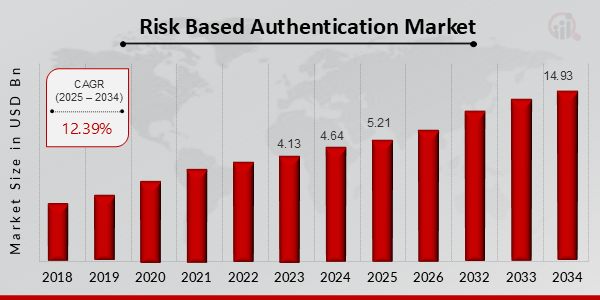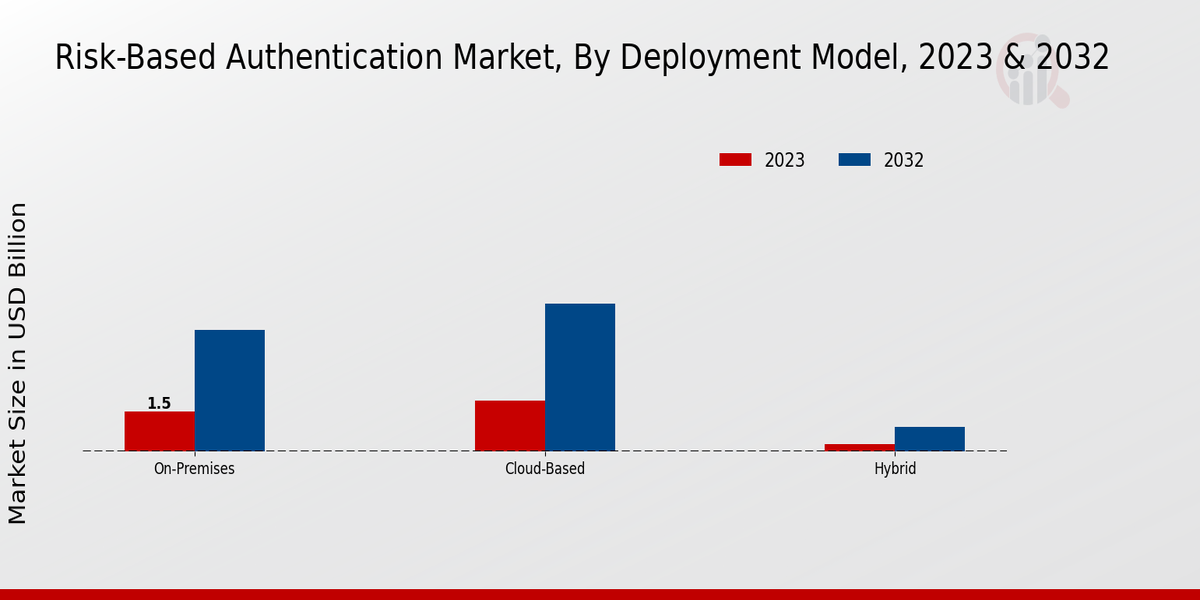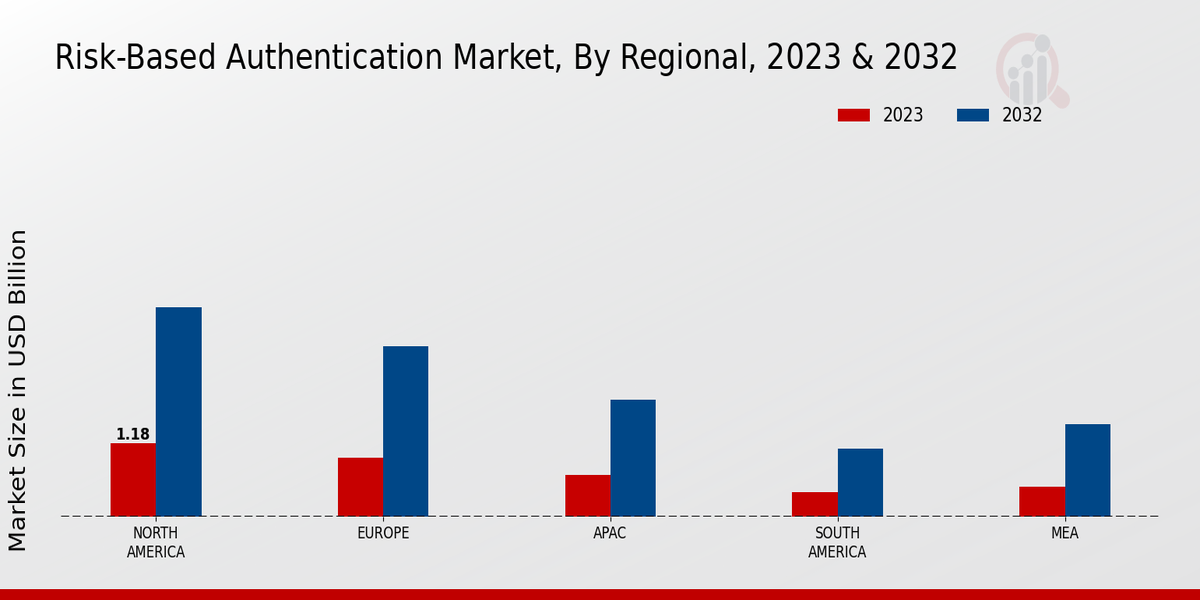Risk-based Authentication Market Overview
As per MRFR analysis, the risk-based authentication market size was estimated at 3.27 (USD billion) in 2022. The risk-based authentication market is expected to grow from 3.67 (USD billion) in 2023 to 10.5 (USD billion) by 2032. The risk-based authentication market CAGR (growth rate) is expected to be around 12.39% during the forecast period (2024 - 2032).
Key Risk-based Authentication Market Trends Highlighted
The Risk-based Authentication Market is currently being driven by an increasing demand for enhanced security measures across various sectors. As cyber threats continue to evolve, organizations are increasingly adopting risk-based authentication to secure sensitive information and enhance user experiences.mThis adaptive authentication approach, which evaluates risk levels in real time, allows companies to stay ahead of potential breaches, thus making it a favored choice for identity verification processes. As more businesses transition to digital platforms, the need for robust authentication solutions becomes even more critical, further propelling the market's growth.
Opportunities to be explored include the integration of artificial intelligence and machine learning technologies into authentication systems. These advancements can help analyze user behaviors more effectively, enabling systems to identify anomalies and reduce false positives. Furthermore, as consumer awareness of data security rises, there is a growing market for solutions that offer seamless and user-friendly experiences while maintaining high-security standards.
This focus on user-centric solutions presents a unique opportunity for providers to differentiate their offerings and capture a larger market share. Recent trends have shown a shift towards multi-factor authentication and a stronger emphasis on mobile security. Organizations are increasingly recognizing the importance of not just traditional passwords but also biometric authentication methods and contextual factors like location and device behavior. As regulatory requirements for data protection tighten globally, many businesses are looking to adopt comprehensive risk-based strategies to ensure compliance. This trend is expected to continue as organizations seek to fortify their defenses against potential vulnerabilities, thereby shaping the future landscape of the risk-based authentication market.
Figure 1 Risk Based Authentication Market Overview (2025-2034)

Source: Primary Research, Secondary Research, MRFR Database and Analyst Review
Risk-based Authentication Market Drivers
Growing Cybersecurity Threats
The increasing frequency and sophistication of cyberattacks have significantly heightened the demand for advanced security solutions, which is a critical driver for the Risk-based Authentication Market.As organizations become more reliant on digital platforms for operations and transactions, they are also becoming more vulnerable to security breaches. Traditional authentication methods, such as passwords, are often insufficient to combat these threats. Risk-based authentication offers a proactive approach to security by assessing the risk level associated with each user’s login attempt or transaction in real-time.
This method allows organizations to implement additional security measures only, when necessary, thus optimizing the user experience while enhancing security controls. Companies are recognizing the necessity of real-time user behavior analysis to ensure that they protect sensitive information without compromising accessibility. The ongoing evolution of cyber threats, such as phishing attacks, ransomware, and insider threats, underscores the relevance of robust authentication methods. As budgets for cybersecurity continue to expand, investments in technologies that incorporate risk assessment and multi-factor authentication will likely drive demand for solutions within the Risk-based Authentication Market.
Regulatory Compliance Requirements
With the rise of data protection regulations worldwide, businesses are increasingly pressured to comply with stringent security and privacy standards. The Risk-based Authentication Market is being driven by the need for organizations to adhere to regulations such as GDPR, HIPAA, and others that mandate strong user authentication processes.
Compliance not only protects consumer data but also shields organizations from potential fines and reputational damage that can occur from data breaches. As organizations strive to meet these regulations, they find risk-based authentication solutions appealing as they enable dynamic, context-aware security measures to align with compliance requirements.
Increase in Digital Transactions
The global shift towards digital transactions, spurred by factors such as e-commerce growth and mobile banking, is a significant driver for the Risk-based Authentication Market. As more consumers adopt digital platforms for shopping, banking, and other services, the need for secure transaction processes increases. Risk-based authentication solutions facilitate this need by providing an additional layer of security, ensuring that both consumers and service providers can safely engage in digital exchanges.Companies are prioritizing user experience while maintaining high-security standards to foster trust among their customers, propelling growth in the risk-based authentication sector.
Risk-based Authentication Market Segment Insights
Risk-based Authentication Market Deployment Model Insights
The Risk-based Authentication Market revenue is significantly shaped by the Deployment Model, which is categorized into On-Premises, Cloud-Based, and Hybrid models. In 2023, the On-Premises model was valued at 1.5 USD billion, showcasing a growing demand for businesses seeking more control over their security infrastructure. This model appealed to organizations needing to manage sensitive information internally, hence leading to a majority holding in the market. Cloud-Based solutions generate even higher revenue, estimated at 1.9 USD billion in the same year, highlighting a trend toward greater flexibility and lower maintenance costs, making it particularly appealing for companies that prioritize scalable solutions.
The Hybrid model, on the other hand, was valued at 0.27 USD billion in 2023, positioning it as a segment that offers a mixed approach, allowing businesses to leverage both On-Premises and cloud features, which is crucial in transitioning towards modern authentication practices. Despite its smaller market share, its importance lies in its ability to cater to organizations hesitant about fully committing to cloud-based systems while still seeking to enhance their security measures.
As businesses increasingly rely on digital channels and face the growing threat of cyberattacks, the demand for effective authentication solutions across these deployment models is expected to rise. The Risk-based Authentication Market statistics reflect a robust interest in these segments, with businesses adapting their strategies to best fit their operational needs and security frameworks. This dynamic landscape showcases a range of opportunities and challenges that organizations must navigate in selecting a suitable deployment model, ultimately driving market growth and innovation.
Figure 2 Risk Based Authentication Market By Deployment Model Insights (2023-2032)

Source: Primary Research, Secondary Research, MRFR Database and Analyst Review
Risk-based Authentication Market Authentication Method Insights
The segment encompasses various techniques for securing access, with Password-Based authentication traditionally being the most utilized method. However, the rise of cyber threats has prompted a shift towards more secure solutions such as Biometric Authentication, which leverages unique physical characteristics, and Multi-Factor Authentication, which combines multiple verification methods for enhanced security. Single Sign-On also plays a crucial role by offering users a seamless experience across multiple applications while maintaining security integrity. These methods contribute to significant market growth as organizations strive to improve their security posture amidst evolving cyber threats.
The emphasis on stronger, multifaceted authentication strategies reflects the growing awareness of the importance of robust identity verification measures, making the Authentication Method segment a critical focus area within the Risk-based Authentication Market. Emerging trends like the increasing adoption of cloud-based services and mobile application usage further amplify the need for efficient authentication solutions, thus shaping the overall landscape of market segmentation relevant to this domain.
Risk-based Authentication Market End User Insights
The Risk-based Authentication Market demonstrates a robust growth trajectory driven by increasing concerns over cybersecurity and the demand for enhanced user verification methods across various sectors.The BFSI sector plays a vital role, as financial institutions require stringent security measures to protect sensitive customer information and transactions. Similarly, the Healthcare industry is an essential end user due to the need to safeguard patient data while ensuring access to authorized personnel.
The Government sector also significantly impacts this market, necessitating secure authentication processes to protect sensitive national information. In the Retail sector, the rise of e-commerce has spurred the adoption of risk-based authentication solutions to combat fraud and improve customer trust. The diverse applications of risk-based authentication solutions highlight the Risk-based Authentication Market segmentation, indicating that each end user contributes to the overall growth and demand for advanced security measures. With ongoing advancements in technology, the market presents numerous opportunities for innovation and development.
Risk-based Authentication Market Organization Size Insights
The segmentation by Organization Size reveals distinct categories, namely Small Enterprises, Medium Enterprises, and Large Enterprises. Each of these categories reflects unique characteristics and needs in implementing risk-based authentication solutions.Small Enterprises often prioritize cost-effectiveness due to limited budgets while balancing security needs. In contrast, Medium Enterprises tend to experience significant growth and require more robust solutions to manage increased transaction volumes and fraud risks.
Large Enterprises dominate the market, necessitating extensive security measures due to the high stakes involved in handling large amounts of sensitive data. This segment significantly drives the market growth due to the complex security requirements and resources they possess, enabling them to implement advanced authentication strategies. The expanding need for secure online transactions and the rise of cyber threats are vital growth drivers across all organization sizes, presenting both challenges and opportunities for the Risk-based Authentication Market as it adapts to diverse operational needs.
Risk-based Authentication Market Regional Insights
The Risk-based Authentication Market is experiencing substantial growth across various regions, with North America leading the charge. In 2023, North America held a significant value of 1.179 USD billion, expected to grow to 3.344 USD billion by 2032, showcasing its dominant presence in the market. Europe followed with a notable valuation of 0.943 USD billion in 2023, with prospects reaching 2.722 USD billion by 2032, contributing significantly to the market growth due to increasing cybersecurity demands. The Asia-Pacific (APAC) region also played a crucial role, valuing at 0.668 USD billion in 2023 and anticipated to reach 1.867 USD billion by 2032, reflecting its growing technological advancements and digital transformation initiatives.
South America, with a valuation of 0.393 USD billion in 2023 and projected growth to 1.089 USD billion by 2032, indicated expanding opportunities despite being a smaller market. Meanwhile, the Middle East and Africa (MEA) also showed potential, with a valuation of 0.487 USD billion in 2023 and expectations of 1.478 USD billion by 2032, driven by increasing awareness of online security threats. Overall, the Risk-based Authentication Market segmentation demonstrates varying degrees of growth and opportunity across regions, highlighting the critical demand for robust security solutions globally.
Figure 3 Risk Based Authentication Market By Regional Insights (2023-2032)

Source: Primary Research, Secondary Research, MRFR Database and Analyst Review
Risk-based Authentication Market Key Players and Competitive Insights
The Risk-based Authentication Market is characterized by a dynamic landscape of competition driven by the increasing need for secure online access and digital transactions. As cyber threats evolve, businesses across various sectors are prioritizing the implementation of advanced authentication methods to ensure user identity verification while maintaining a seamless user experience. This market is bustling with innovative solutions that leverage machine learning, behavioral biometrics, and multifactor authentication to assess risk levels effectively. Players in this market continuously strive to enhance their offerings, adapt to regulatory changes, and address emerging threats, forging partnerships and leveraging integrations to deliver comprehensive security solutions.
As organizations navigate the complexities of digital security, competitors are focused on providing tailored solutions that balance security needs with user convenience, positioning themselves strategically to capture greater market share. Microsoft stands out in the Risk-based Authentication Market due to its robust portfolio of security solutions and a strong commitment to integrating security throughout its product ecosystem. Known for its extensive research and development efforts, Microsoft employs advanced machine learning algorithms and behavioral analytics to accurately evaluate risk factors associated with user login attempts.
The company harnesses its vast cloud infrastructure to deliver scalable and resilient authentication solutions that can adapt to an organization's specific needs. The strength of Microsoft lies not only in its technological prowess but also in its reputation and established brand loyalty within the enterprise sector.Furthermore, Microsoft's initiatives in cybersecurity training and awareness elevate its market presence, making it a go-to choice for businesses seeking reliable and forward-thinking risk-based authentication solutions. SAS Institute is another key player in the Risk-based Authentication Market, recognized for its expertise in analytics and data-driven security solutions. The company's advanced analytics capabilities allow for real-time monitoring and decision-making processes essential for identifying risk levels during authentication.
SAS Institute utilizes its proven methodologies in predictive analytics to enhance threat detection, allowing organizations to implement more effective authentication processes tailored to individual user behaviors.The company is well-regarded for its ability to provide actionable insights and a comprehensive suite of analytical tools that support risk assessments, ultimately empowering businesses to mitigate fraud and improve security protocols. With a focus on innovation and a deep understanding of analytical processes, SAS Institute strengthens its position within the competitive landscape by offering advanced, customer-centric solutions that address the complexities of risk-based authentication.
Key Companies in the risk-based authentication market Include
- Microsoft
- SAS Institute
- Oracle
- BioCatch
- IBM
- OneSpan
- LexisNexis Risk Solutions
- Entrust
- ForgeRock
- FIS
- RSA Security
- Auth0
- Ping Identity
- Gemalto
- Okta
Risk-based Authentication Market Developments
The Risk-based Authentication Market has witnessed significant activity recently, marked by several key developments. Companies like Microsoft and Oracle continue to enhance their security offerings, implementing advanced machine-learning techniques to improve user verification processes. Additionally, BioCatch has been gaining traction for its behavioral biometrics, while IBM is focusing on integrating AI capabilities into its authentication solutions to better mitigate fraud risks. In terms of financial growth, the market has experienced a surge in valuation, driven by an increased demand for robust security measures against rising cyber threats.
Recently, reports have surfaced indicating potential mergers and acquisitions involving companies such as OneSpan and RSA Security, which aim to consolidate and strengthen their market positions amidst escalating competition. This wave of consolidations signifies a strategic shift within the industry as firms seek to combine resources to enhance their technological capabilities. The market is expected to expand further as organizations increasingly prioritize identity verification solutions to protect sensitive information across digital platforms.
Risk-based Authentication Market Segmentation Insights
-
Risk-based Authentication Market Deployment Model Outlook
- On-Premises
- Cloud-Based
- Hybrid
-
Risk-based Authentication Market Authentication Method Outlook
- Password-Based
- Biometric Authentication
- Multi-Factor Authentication
- Single Sign-On
-
Risk-based Authentication Market End User Outlook
- BFSI
- Healthcare
- Government
- Retail
- Risk-based Authentication Market Organization Size Outlook
- Small Enterprises
- Medium Enterprises
- Large Enterprises
- Risk-based Authentication Market Regional Outlook
- North America
- Europe
- South America
- Asia Pacific
- Middle East and Africa
|
Report Attribute/Metric
|
Details
|
|
Market Size 2024
|
4.64 (USD Billion)
|
|
Market Size 2025
|
5.21 (USD Billion)
|
|
Market Size 2034
|
14.93 (USD Billion)
|
|
Compound Annual Growth Rate (CAGR)
|
12.39% (2025 - 2034)
|
|
Report Coverage
|
Revenue Forecast, Competitive Landscape, Growth Factors, and Trends
|
|
Base Year
|
2024
|
|
Market Forecast Period
|
2025 - 2034
|
|
Historical Data
|
2019 - 2023
|
|
Market Forecast Units
|
USD Billion
|
|
Key Companies Profiled
|
Microsoft, SAS Institute, Oracle, BioCatch, IBM, OneSpan, LexisNexis Risk Solutions, Entrust, ForgeRock, FIS, RSA Security, Auth0, Ping Identity, Gemalto, Okta
|
|
Segments Covered
|
Deployment Model, Authentication Method, End User, Organization Size, Regional
|
|
Key Market Opportunities
|
Increased cybersecurity threats, Expanding online transactions, Adoption in e-commerce platforms, Regulatory compliance requirements, and Growth in mobile authentication solutions
|
|
Key Market Dynamics
|
Rising cyber threats, Increasing regulatory compliance, Adoption of digital transformation, Enhancing user experience, and Growth in online transactions
|
|
Countries Covered
|
North America, Europe, APAC, South America, MEA
|
Frequently Asked Questions (FAQ) :
The Risk-based Authentication Market is expected to be valued at 14.93 USD billion in 2034.
The expected CAGR for the Risk-based Authentication Market from 2025 to 2034 is 12.39%.
North America is projected to have the largest market share, valued at 3.344 USD billion by 2032.
The Cloud-Based deployment model is expected to reach a market size of 5.5 USD billion in 2032.
The On-Premises deployment model is projected to be valued at 4.5 USD billion in 2032.
The APAC region is estimated to reach a market size of 1.867 USD billion in 2032.
Key players in the Risk-based Authentication Market include Microsoft, SAS Institute, Oracle, and IBM, among others.
The Hybrid deployment model is expected to be valued at 0.9 USD billion in 2032.
The South American region is projected to reach a market size of 1.089 USD billion in 2032.
Key growth drivers for the Risk-based Authentication Market include increasing security needs and advancements in authentication technologies.

















